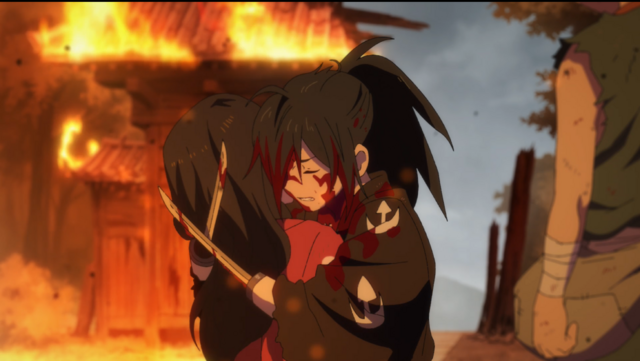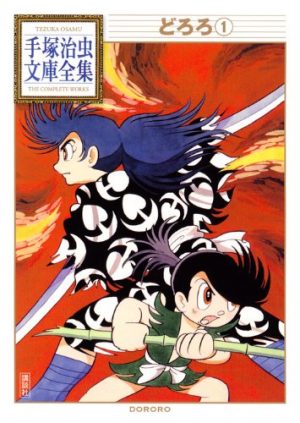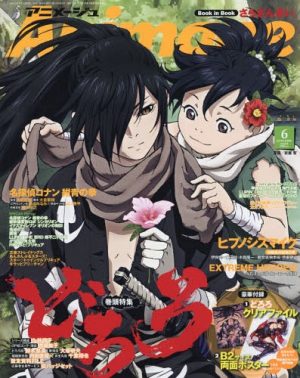
Whether you watch the 2019 remake or the original 1969 series, Dororo is a story of redemption. Due to the difficulties of the times during feudal Japan, a lot of regular citizens and samurai alike are living under hardship to the point they do morally questionable things to stay alive. When you take into account that people back then had no other recourse to provide for themselves and their love dones, they still do what they can to make up for it. So, we would like to share some of the top 10 redemptive characters in Dororo.
10. Nui no Kata
Kicking off this list is Nui, the mother of Hyakkimaru and Tahomaru. Upon her introduction, her child, who was born beyond deformed, is instantly taken from her and since then, Nui has pretty much lived a reclusive life praying for forgiveness. While it is easy to forgive her in her situation since she had no power over what happened, she does feel a burden of responsibility. As the wife of Daigo and the mother of Tahomaru, you would assume she would do more to contribute to the upbringing but instead, lives in sadness and keeps her headless statue of Kanon as a memento to never forget.
Upon reuniting with Hyakkimaru, she comes to terms with the situation and the fact that she helps Dororo, Hyakkimaru, and Tahomaru all come to peace with themselves after everything that happens shows her redemption that she has found meaning in her life.
9. Yajiro
On the surface, Yajiro seems like your typical feudal villager who just wants to make an honest living in a village that is under the iron fist of a brutal dictator. He is someone who is willing to help others as he meets a mysterious young woman who fainted by a field of flowers. As crazy as it sounds, that woman happens to be a demon who has been devouring some of the local men. But thanks to Yajiro’s kindness, the demon can learn compassion and by the end of the episode, she loses the maliciousness inside of her.
As it also turns out, Yajiro is responsible for the so-called disappearances in his village because he was actually helping people escape the village because they couldn’t tolerate living under the dictator anymore. Lastly, even when he discovered that the young lady was a demon, he still stood by her showing that despite her sins, that he wanted to be with her. The fact that he’s willing to protect someone like her shows a distinguishing kind of redemption.
8. Itachi
Itachi is the worst kind of backstabber you could ever see. He was once the trusted right-hand man to Dororo’s parents only to betray them at the drop of a dime before being backstabbed himself. He kidnaps Dororo to find the treasure his parents left behind and on their journey to find it, they are met with some crazy obstacles. During the fight against Tahomaru and his soldiers, Itachi loses his crew. Though he doesn’t get the treasure, the fact that he can see it before he draws his last breath is enough for him. In the end, Dororo finds it in his heart to forgive Itachi and hopes he can find peace with his parents in the afterlife, which is enough to give him a form of redemption.
7. Saru
Saru is an orphan who chooses to live alone in a cave like he’s Bin Laden, and the closest thing to family he has is Oume, a village teenager who he refers to as his sister. Initially, he doesn’t want to live with people because the village wants to sacrifice Oume to a demon. Thanks to the intervention of Hyakkimaru and Dororo, they were able to save Oume, and through Oume, Saru can find his redemption and return to civilization once again.
6. Ohagi (Jorogumo)
On the outside, Ohagi seems like a beautiful woman and any man would die to have her. In a way, that is true since she’s really a demon who uses her beauty to lure men so she can devour them. However, her encounter with Yajiro, a local from the village who takes care of her, changes her perceptions on humans. He takes her to his own home and feeds her. Eventually, Ohagi comes to acknowledge Yajiro’s kindness and Yajiro doesn’t care if she’s a demon and is willing to be with her. In the end, Ohagi shows her redemption as she’s willing to protect Yajiro and also wants to be with him.
5. Mio
Shortly after Hyakkimaru regains his hearing, he has difficulty dealing with all the noises. However, the only sound that he finds soothing is Mio’s singing. While Mio’s a teenager herself, she’s the sole caretaker of a group of orphans who have lost limbs. The children tell Hyakkimaru and Dororo that she works nights to provide for them and as it turns out, she makes her money by prostituting herself to local samurai to the point that she has a noticeable disease on her skin.
Prostitution involving minors in the real world is a despicable thing. Many of them are victims of human trafficking. In the case of Mio, she’s doing it out of free will and it’s the only thing she can do with all the mouths she has to feed. Her situation is certainly a question of do-the-ends-justify-the-means. Though her actions unfortunately lead to her doom, her intentions of wanting to make a rice farm for the village demonstrate her redemption showing that she could’ve died of her disease at any moment’s notice but she was ready to leave something behind for the children to take care of themselves.
4. Tahomaru
Compared to his 1969 counterpart, the 2019 Tahomaru is a much more sympathetic and engaging character. Tahomaru is a prince-like figure who wants to become stronger and truly understands what a leader is. He knows leadership is about serving the people and not the other way around. If a village has a problem, he’s willing to take care of the problem himself because that’s what a real leader does. However, his darker turn is a result of Hyakkimaru’s presence. Tahomaru comes to terms that he is his brother but sees that if the land they live on needs to continue its prosperous wealth, he can’t allow Hyakkimaru regain his body.
As a result, he and his two servants sacrifice themselves to the final statue in the Hall of Hell in order to maintain the present order. However, in the final battle, Tahomaru loses and in his final moments, acknowledges his sins, gives Hyakkimaru back his eyes, and comes to terms with everything and wants Hyakkimaru to live his life. The fact he could die in peace knowing what he did was wrong shows anyone can be redeemed, even with seconds left to live.
3. Jukai
Prior to adopting Hyakkimaru, Jukai served a warlord that was hated by the people due to his merciless killings. Due to his former association with that warlord, no one wants anything to do with him and his own student abandons him since he lost his parents to that warlord. While the series doesn’t state if Jukai was directly involved in the warlord’s killings, Jukai is guilty by association in the society that he lives in.
He dedicates the rest of his life to making prosthetics for people who lost limbs, and to corpses on the battlefield to give them a complete body. Shortly after losing his disciple, he found the baby Hyakkimaru and decided to raise him. The fact that he goes out of his way to help others to atone for being associated with a brutal warlord shows that the path to redemption is certainly not easy and is probably lifelong.
2. Hyakkimaru
Hyakkimaru, the main lead, is our number two pick. The story revolves around him killing demons in order to regain his body. As he regains his sense of touch, smell, hearing, and ability to speak, he begins to express himself more, discover new kinds of emotions, and you see how it affects his development. As he discovers love and compassion through Mio, you see how it also negatively affects him when samurai kill her and the children he takes for, thus giving him how to feel rage.
Hyakkimaru progressively becomes a darker character to the point Dororo warns him that if he continues to go down his path, even if he regains his body, he will be no different from the demons he is out to kill. Through Hyakkimaru, you get a redemption story where even if you have a human body, it’s also important to know what it’s like to have a heart and soul, and what it truly means to be human.
1. Dororo
At number one, we have the titular character, Dororo. When we are first introduced to the character, he was a thief and was trying to con people so he can support himself (though it is later revealed he is a girl, but out of respect for gender identity we will refer to Dororo as a boy since that is the character’s personal identity, but that’s another topic for another time). As a matter of fact, the name Dororo comes from Osamu Tezuka’s childhood memories of him and other children couldn’t properly pronounce “Dorobo,” meaning “thief.” As a result, Dororo is introduced as one. Yes, stealing is wrong and many people try to justify it because they need to eat and Dororo being a child makes us question that. Furthermore, we also see him suffer the consequences during his introduction.
After being incidentally saved by Hyakkimaru, he stays by his side through the rest of the series. After witnessing Hyakkimaru kill a platoon samurai in a blind rage after they killed Mio and the children at an abandoned temple, Dororo dedicates himself to helping Hyakkimaru maintain his humanity, which is why the character is redeeming. Plus, he used the secret his parents left him to help others. Even when he had nothing, he did what he could to help and gives up on stealing.
Final Thoughts
Lastly, as a spoiler, we also have to give some acknowledgment to Daigo, Hyakkimaru’s father. He did a despicable thing by sacrificing his own son for the sake of his land, during a period when it was not flourishing. However, his own lust for power consumed him and was willing to kill his own son just to maintain his status quo. By the time we get to the ending, Daigo and Hyakkimaru have one final confrontation. Instead, Hyakkimaru chooses to show mercy and gives Daigo the chance to redeem himself. In the end, Daigo comes to terms with what he has done and that if he didn’t sacrifice Hyakkimaru, then maybe things could have turned out differently. While he can’t take back what he did, the fact that he acknowledges what he did was wrong shows some form of redemption.
Through these characters, we learn that everybody can make bad decisions or simple mistakes. However, we do deserve a chance to redeem ourselves. In some instances, it’s acknowledging remorse shortly before dying, or dedicating yourself to some cause such as helping people. We learn that there’s always time and it’s time we should use wisely.
Recommended Post
Anime vs. Manga: Dororo
Recommended Post
Top 5 Dororo Characters
Recommended Post
6 Anime Like Dororo [Recommendations]
Recommended Post





